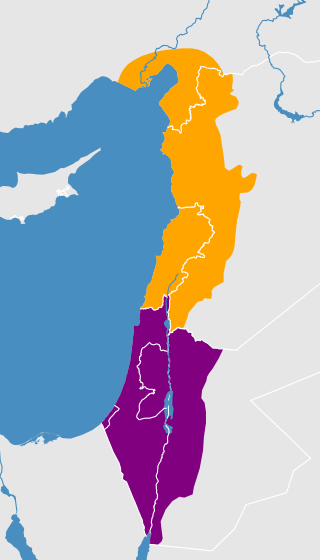
Back لهجة فلسطينية Arabic Палестински арабски език Bulgarian Arabeg levantek ar su Breton Palästinensisch-Arabisch German Παλαιστινιακά αραβικά Greek Palestina araba dialekto Esperanto Árabe palestino Spanish Palestinar arabiera Basque عربی فلسطینی Persian Arabe palestinien French
It has been suggested that Modern Palestinian Judeo-Arabic be merged into this article. (Discuss) Proposed since January 2024. |
This article has multiple issues. Please help improve it or discuss these issues on the talk page. (Learn how and when to remove these template messages)
|
| Palestinian Arabic | |
|---|---|
| اللهجة الفلسطينية | |
| Native to | Palestine |
Native speakers | 4.3 million (2021)[1] |
| Dialects |
|
| Arabic alphabet | |
| Language codes | |
| ISO 639-3 | (covered by apc) |
| Glottolog | sout3123 |
 | |
Palestinian Arabic is a dialect continuum of mutually intelligible varieties of Levantine Arabic spoken by most Palestinians in Palestine, Israel and in the Palestinian diaspora.[2][3]
The Arabic dialects spoken in Palestine and Transjordan are not one more or less homogeneous linguistic unit, but rather a wide diversity of dialects belonging to various typologically diverse groupings due to geographical, historical, and socioeconomic circumstances.[4] In two dialect comparison studies, Palestinian Arabic was found to be the closest Arabic dialect to Modern Standard Arabic,[5] mainly the dialect of the people in Gaza Strip.[6] Further dialects can be distinguished within Palestine, such as spoken in the northern West Bank, that spoken by Palestinians in the Hebron area, which is similar to Arabic spoken by descendants of Palestinian refugees living in Jordan and south-western Syria.[citation needed]
Palestinian dialects contain layers of languages spoken in earlier times in the region, including Canaanite, Hebrew (Biblical and Mishnaic), Aramaic (particularly Western Aramaic), Persian, Greek, and Latin. As a result of the early modern period, Palestinian dialects were also influenced by Turkish and European languages. Since the founding of Israel in 1948, Palestinian dialects have been significantly influenced by Modern Hebrew.[7]
- ^ Palestinian Arabic at Ethnologue (26th ed., 2023)

- ^ "How to Reach your Audience with the Right Dialect of Arabic". Asian Absolute. 2016-01-19. Retrieved 2020-06-24.
- ^ "Arabic Language: Tracing its Roots, Development and Varied Dialects". Day Translations. 2015-10-16. Retrieved 2020-06-24.
- ^ Palva, H. (1984). A general classification for the Arabic dialects spoken in Palestine and Transjordan. Studia Orientalia Electronica, 55, 357-376.
- ^ Kwaik, K.; Saad, M.; Chatzikyriakidis, S.; Dobnik, S. (2018). "A Lexical Distance Study of Arabic Dialects". Procedia Computer Science. The 4th International Conference on Arabic Computational Linguistics (ACLing). 143 (published 15 November 2018): 1, 3. doi:10.1016/j.procs.2018.10.456. ISSN 1877-0509.
{{cite journal}}: CS1 maint: multiple names: authors list (link) - ^ Harrat, S.; Meftouh, K.; Abbas, M.; Jamoussi, S.; Saad, M.; Smaili, K. (2015). "Cross-Dialectal Arabic Processing". Computational Linguistics and Intelligent Text Processing. Gelbukh, Alexander (Ed.). Lecture Notes in Computer Science. Vol. 9041. Springer, Cham. (published April 14–20, 2015). pp. 3, 6. doi:10.1007/978-3-319-18111-0_47. ISBN 978-3-319-18110-3. S2CID 5978068. Retrieved 29 November 2022.
{{cite book}}: CS1 maint: multiple names: authors list (link) - ^ Bassal, Ibrahim (2012). "Hebrew and Aramaic Substrata in Spoken Palestinian Arabic". Mediterranean Language Review. 19: 85–104. ISSN 0724-7567. JSTOR 10.13173/medilangrevi.19.2012.0085.